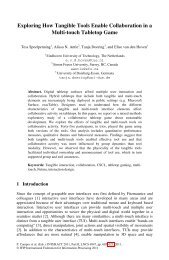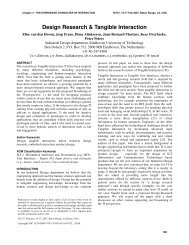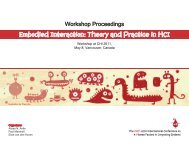Sissy - Elise van den Hoven
Sissy - Elise van den Hoven
Sissy - Elise van den Hoven
Create successful ePaper yourself
Turn your PDF publications into a flip-book with our unique Google optimized e-Paper software.
Cognitive-behavioural approaches are used by clinical<br />
staff help children develop a sense of control over their<br />
situation, through processes of rehearsal, desensitisation<br />
and the customisation of various details of the<br />
procedure (i.e. have nitrous oxide gas whilst sitting up,<br />
only a few people in the room at start of procedure,<br />
siting in parents lap etc.). These approaches lower<br />
anxiety by a process of familiarisation and the building<br />
of trust.<br />
Systematic Desensitization is another popular related<br />
approach - in which the anxiety provoking procedure is<br />
broken down into steps that children negotiate via<br />
increasing levels of approximation to the actual<br />
procedure. Medical Play similarly facilitates a process<br />
of familiarisation and mental remodelling - where<br />
children work with a Nurse of trained Child-Life<br />
Therapist (a.k.a. Play Therapist) and perform a version<br />
of the medical procedure on toys enabling the child to<br />
build a realistic and safe-feeling narrative and rationale<br />
for the procedure, thereby reducing anticipatory<br />
anxieties that stem largely from the child’s fear of the<br />
unknown.<br />
With the increasing ubiquity of mobile multimedia<br />
devises like portable video players, mobile phones and<br />
tablet computers (i.e., iPads), and the immediate sense<br />
of connection that most children demonstrate with these<br />
devices, there is now understandably, considerable<br />
interest in the use of these recreational and<br />
entertainment technologies as Distraction tools for<br />
managing paediatric pain and procedure related<br />
anxieties.<br />
Figure 1. Prototype BrightHearts iPad app in use -<br />
combining multimedia distraction and biofeedback<br />
assisted relaxation training (Photo Julia Charles).<br />
Malloy and Milling’s (2010) systematic review of<br />
eleven comparative studies on Immersive Virtual /<br />
Augmented Reality distraction, revealed these methods<br />
to be effective for reducing experimental pain, as well<br />
as the discomfort associated with burn injury care, with<br />
studies focussed on needle-related pain providing less<br />
18<br />
consistent findings. They suggest that VR distraction<br />
may be a useful tool for clinicians working with a<br />
variety of pain problems.<br />
Compared to research on Augmented and Virtual<br />
Reality Distraction methods, Biofeedback Assisted<br />
Relaxation Training (BART) remains a relatively<br />
under-explored set of approaches for paediatric acute<br />
pain and anxiety management (as distinct from the<br />
many studies focusing on its use in the treatment<br />
migraines, headaches and specific psychological<br />
problems such as Generalized Anxiety, Panic and<br />
Posttraumatic Stress disorders).<br />
BIOFEEDBACK TRAINING: A DEFINITION<br />
Biofeedback training is method by which individuals<br />
learn to voluntarily sense and then control some aspect<br />
of the physiology, utilizing electronic or<br />
electromechanical instruments to measure, process and<br />
display information back (‘feedback’) in such a way<br />
that subjects can eventually learn to sense and then<br />
influence the behaviour being observed, usually via<br />
auditory and/or visual displays. The objective of<br />
biofeedback training is to help people develop a greater<br />
awareness and voluntary control over physiological<br />
processes - first by way of the external displays, and<br />
then via internal psychological cue (Schwartz and<br />
Olsen, 1995). Biofeedback is not a process of electromechanical<br />
coercion in which people are ‘shocked’ or<br />
‘brainwashed’ into shape - nothing is ‘done to’ the<br />
trainee in the sense of conventional medical treatment –<br />
and its effectiveness relies to a large extent on the<br />
motivation of the subject to interact with the<br />
biofeedback display (i.e. ‘play the game’).<br />
Biofeedback training supports a philosophy of selfregulation<br />
and empowerment that has significance<br />
beyond the immediate rehabilitation of the specific<br />
functions being trained. Skills gained in the regulation<br />
of specific body functions i.e. heart rate, temperature,<br />
brainwave activity, muscle control etc. often generalise<br />
into an increased sense of self-efficacy - an inner<br />
conviction that the individual can make a positive<br />
difference to their experience and situation. Such beliefs<br />
can in turn generalise into more active mastery over<br />
psycho-social problems (Davies, 2003).<br />
We hypothesize that these affirming beliefs and selfrepresentations<br />
may have a positive impact on how<br />
subjects perceive and manage their experience of<br />
procedural pain.<br />
Biofeedback training in paediatric healthcare<br />
While the efficacy of biofeedback for the management<br />
of acute pain and anxiety associated with painful<br />
procedures has not been established - there is some<br />
evi<strong>den</strong>ce to support its efficacy in the management of<br />
paediatric headache, recurrent abdominal pain,<br />
constipation, burns self-catheterization procedures and<br />
functional dyspepsia related to duo<strong>den</strong>al eosinophilia.<br />
Gil et al. (1988) evaluated the effectiveness of a<br />
package of biofeedback and behavioural techniques<br />
designed to reduce a child’s distress associated with



![Download 1.8 MB [pdf] - Elise van den Hoven](https://img.yumpu.com/18078175/1/190x245/download-18-mb-pdf-elise-van-den-hoven.jpg?quality=85)

![Download 0.2 MB [pdf] - Elise van den Hoven](https://img.yumpu.com/18078145/1/182x260/download-02-mb-pdf-elise-van-den-hoven.jpg?quality=85)
![Download 0.1 MB [pdf] - Elise van den Hoven](https://img.yumpu.com/18078125/1/190x146/download-01-mb-pdf-elise-van-den-hoven.jpg?quality=85)
![Download 1.9 MB [pdf] - Elise van den Hoven](https://img.yumpu.com/18078041/1/182x260/download-19-mb-pdf-elise-van-den-hoven.jpg?quality=85)

